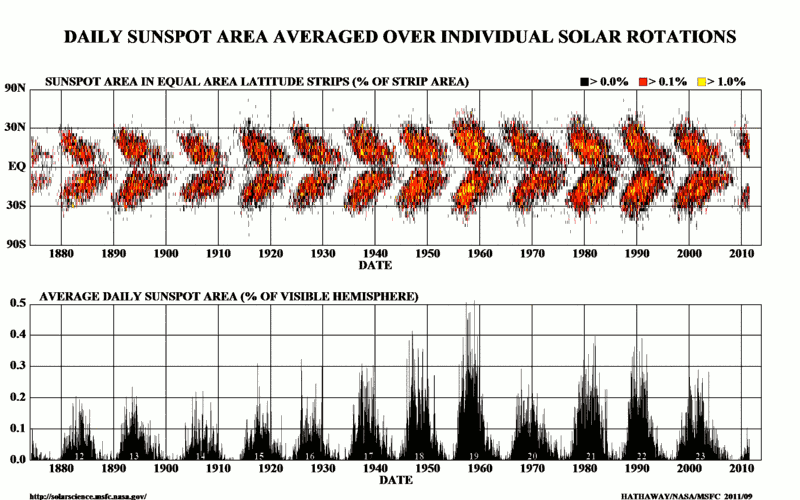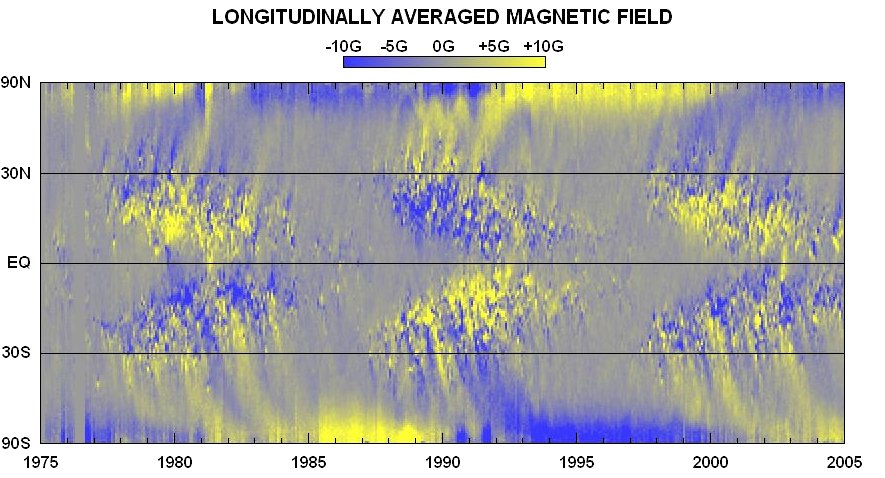Sunspots
- Sunspots occur in a repeating cycle lasting ~11.2 years (or double that to include the polarity reversal described below). These cycles have been occurring as far back in time as we can tell. (Geologic evidence of an 11-year solar cycle goes back hundreds of millions of years.) The number of sunspots varies from near 0 at minima up to 50~150 at maxima. An individual sunspot can persist for a couple of months.
- The Sun releases .1% more energy at the sunspot peak.
- Roughly the same number of spots occur in both hemispheres.
- Sunspots occur on the boundary between a fast-moving band of plasma straddling the equator and a slow-moving band on the polar side.1
- Early in the cycle they are more common at the higher latitudes, while later they are more common nearer the equator. So the fast-moving equatorial band shrinks.
- They typically occur in pairs of opposite EM polarity.
- There can be coronal loops (filaments or prominences) connecting sunspot pairs.
- One spot is usually ahead of the other in the direction in which the Sun rotates. It's possible that both are aligned by the torsional oscillation band.
- The magnetic polarity of the "leading" spot is always the same, and matches the polarity of that hemisphere's rotational pole.
- As the sunspot activity wains, the magnetic polarity at the Sun's poles reverses, and stays that way until the next peak, 11 years later.
- In the next 11-year cycle all of these polarities are reversed.
- Helioseismic data suggest that there is a downdraft underneath sunspots,1 but Doppler shift analysis says that it's an updraft.2 Is it possible that both are true, and that the ions are descending, while the electrons are ascending?
- The surface of a sunspot is ~700 km lower than the surrounding photosphere.
- The temperature of the center of a sunspot (i.e., "umbra") is ~1700 K less than the surrounding photosphere.
- The edge of the sunspot (i.e., "penumbra") is between the temperature of the umbra and the surrounding photospheric granules.
- The magnetic field in the center of a sunspot is ~4,000 Gauss (compared to 1 Gauss in the surrounding photosphere).
- There is a slow migration of granules away from the sunspots.
- There is evidence of very weak vorticity in sunspots.
- In the chromosphere, the structure of the penumbra radiates outward and joins with other flux lines (of some sort). (See this for a comparison of photospheric versus chromospheric emissions.)
Figure 1. Map of velocities in a sunspot as measured using the Doppler effect, where blue means up and red means down. The net-like pattern surrounding the sunspot is solar granulation. The field of view corresponds to 24,000 km on the sun. Image courtesy of The Royal Swedish Academy of Sciences, G. B. Scharmer, V. M. J. Henriques, D. Kiselman, J. de la Cruz Rodriguez.Figure 3. In this "magnetic butterfly diagram," yellow regions are occupied by south-pointing magnetic fields; blue denotes north. At mid-latitudes the diagram is dominated by intense magnetic fields above sunspots. During the sunspot cycle, sunspots drift, on average, toward the equator — hence the butterfly wings. The uniform blue and yellow regions near the poles reveal the orientation of the Sun's underlying dipole magnetic field. Courtesy NASA. (See this also.)
References
1. Zhao, J.; Kosovichev, A. G. (2004): Torsional Oscillation, Meridional Flows, and Vorticity Inferred in the Upper Convection Zone of the Sun by Time-Distance Helioseismology. The Astrophysical Journal, 603: 776 ⇧ ⇧
2. Choi, C. Q. (2012): Mysterious Origins of Dark Sunspots Explained. space.com ⇧













